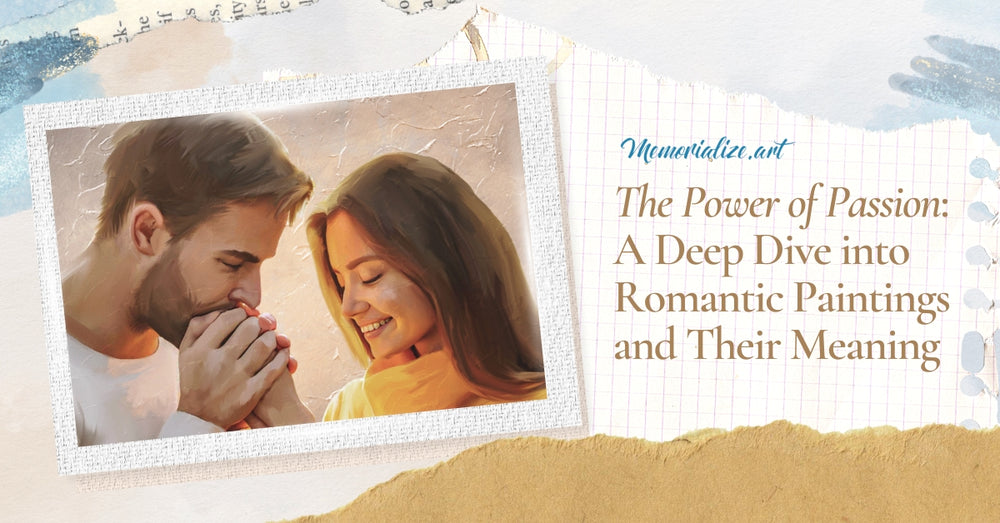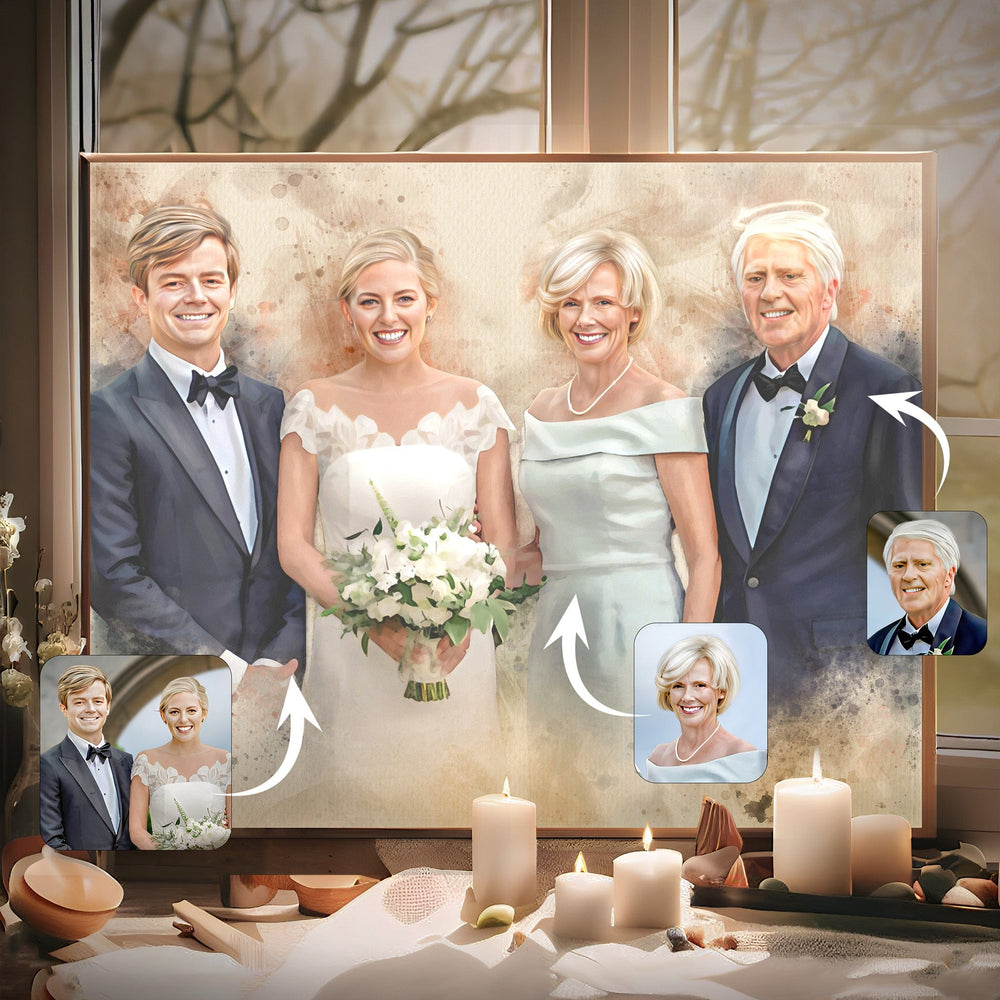The Power of Passion: A Deep Dive into Romantic Paintings and Their Meaning


These paintings are not just pictures, they're stories. They show the artist's feelings or the norms of their time. The passion in these works can make us feel strong emotions and understand the story better. Every color and every line adds to the story of love and desire.
So, get ready to experience the power of passion through art as we unravel the hidden meanings and emotions encapsulated in these masterpieces.
What Defines a Romantic Painting?
Romantic painting, in the simplest of terms, is an artwork that revolves around the theme of love and passion. These paintings often bring to life intimate moments between individuals or showcase scenes filled with longing or desire. However, it's important to note that romantic paintings aren't just limited to depicting love between two people.
They can also be a reflection of an artist's deep love for nature, their passion for humanity, or even their pursuit of an ideal. In essence, what really defines a romantic painting is its ability to emotionally engage the viewer, making them feel part of the narrative.
The Characteristics of Romantic Paintings
There are several distinct features that make romantic paintings stand out. One of the most noticeable traits is the use of vibrant and intense colors. Artists often use this color palette to portray powerful emotions and make the paintings come alive.
In addition, romantic paintings tend to feature dramatic scenes and bold compositions. This reflects the intensity and tumultuous nature of love and passion.
Furthermore, you'll often find symbolic elements in these artworks. For instance, an artist might include flowers or specific objects that hold a deeper meaning related to love or affection. It's these subtle details that add layers to the narrative.
Lastly, and perhaps most importantly, romantic paintings tell a story. They depict a scene that goes beyond the canvas, communicating a profound narrative about love, longing, or desire.
What Emotions Do Romantic Paintings Evoke?
The beauty of romantic paintings lies in their ability to evoke a broad spectrum of emotions. While the specific emotional response can vary from person to person and artwork to artwork, there are some common feelings that these paintings aim to stir.
Passion, love, longing, and desire are typically at the forefront. However, romantic paintings can also evoke feelings of melancholy or nostalgia, especially when they depict a scene of lost love or longing for something that's out of reach.
On the other hand, some romantic paintings can bring about feelings of joy and warmth, capturing those blissful moments of love and connection. Ultimately, the emotions evoked by romantic paintings are as diverse and intricate as the concept of love itself.
Let's go into some specific examples that showcase the beauty and depth of romantic paintings. These artworks, whether they are couple portraits, Valentine's Day-themed paintings, charcoal drawings, or watercolor pieces, all capture the essence of love and romance in their unique ways.
Couple Portraits

Get Your Couple Portraits Here
Couple portraits are a classic genre within romantic painting. These works often depict two individuals sharing an intimate moment or expressing mutual affection. One famous example is Gustav Klimt's "The Kiss," a masterpiece that showcases a couple locked in a passionate embrace. The use of symbolic patterns and rich gold tones in this painting heightens the sense of intimacy and love between the couple.
Valentine's Day Paintings

Order Your Valentine's Day Paintings Here
Valentine's Day paintings are artworks specifically themed around the day of love. They often feature traditional symbols of love, such as hearts, roses, and cupids. An example of a Valentine's Day painting is Marc Chagall's "The Birthday," which depicts a man floating towards his lover to give her a kiss, encapsulating the joy and excitement of love.
Couple Charcoal Drawings

Get Your Couple Charcoal Drawings Here
Couple charcoal drawings offer a unique take on romantic art. Charcoal allows for intense contrast and detail, enabling artists to capture the intricate emotions of a romantic scene. For instance, a simple yet powerful charcoal drawing might depict two lovers' hands intertwined, symbolizing their connection and mutual support.
Couple Watercolor Paintings

Order Your Couple Watercolor Paintings Here
Watercolor is a medium that can beautifully convey the softness and fluidity of love. In a couple of watercolor paintings, the artist may use gentle washes of color to depict a serene moment between two lovers.
The transparency and delicate nature of Couple Watercolor Paintings can evoke a sense of vulnerability and tenderness, enhancing the romantic theme. An example could be a painting featuring a couple walking hand-in-hand under a pastel-colored sky, symbolizing their journey together.
The Most Famous Romantic Paintings and Their Stories
Romantic paintings have always held a special place in the world of art, captivating viewers with their emotional depth and depiction of love. Many such pieces have gained global acclaim, standing the test of time with their enduring appeal.
Let's delve into the fascinating stories behind three of the most renowned romantic paintings that continue to touch hearts worldwide.
"The Kiss" by Gustav Klimt
"The Kiss," painted by Gustav Klimt, is arguably one of the most recognized romantic paintings in existence. Completed in 1908, this masterpiece portrays a couple sharing a passionate kiss on the edge of a cliff, completely lost in their moment of love.
Klimt's use of intricate patterns and gold leaf accentuates the painting, reflecting his fascination with the ornate mosaics of the Byzantine era. The lovers are enveloped in a shower of golden flowers, symbolizing their unity and shared joy. This painting continues to be a symbol of passion and love in popular culture.
"Romeo and Juliet" by Sir Frank Dicksee
"Romeo and Juliet," painted by Sir Frank Dicksee in 1884, is a visual representation of Shakespeare's tragic love story. This painting captures the balcony scene where Romeo and Juliet share a moment of deep love and longing.
Their expressions, along with their body language, convey a sense of profound affection coupled with the impending tragedy of their fate. This artwork serves as a powerful emblem of star-crossed love and continues to resonate with audiences today.
"The Lovers" by René Magritte
René Magritte's "The Lovers," painted in 1928, takes a surrealistic approach to depict love. It features a man and woman attempting to kiss, but their faces are hidden behind white cloths. This painting explores themes of love, longing, and the barriers that prevent true intimacy.
Even with the cloth barrier, the bodies of the lovers lean towards each other, suggesting an irresistible attraction and desire. This piece continues to intrigue viewers with its unique take on love and barriers.
The Cultural Significance of Romantic Paintings
Romantic paintings hold immense cultural significance, serving as mirrors reflecting societal perceptions and representations of love and passion across different eras. These artworks often encapsulate the norms, values, and ideals of their respective periods, providing a historical context of romantic relationships and emotions.
Moreover, romantic paintings have a lasting impact on contemporary culture. They inspire various forms of media, including books, films, fashion trends, and music, extending their influence beyond the confines of the art world.
By portraying universal human emotions such as love, longing, and desire, these artworks create a connection with audiences across different cultures and generations. In essence, romantic paintings not only capture intimate moments of love but also contribute to shaping our collective understanding and expression of human emotions and relationships.
Experience the Magic of Love with Memorialize Art
Art has the power to evoke deep emotions, and romantic art does this beautifully. Famous romantic paintings are not just visually stunning, but they also resonate with us through their timeless themes of love, longing, and passion. At Memorialize Art, we offer a selection of these enchanting romantic paintings for you to own.
Whether you want to enrich your personal collection or gift someone special with a symbol of love, our romantic paintings are the perfect choice. Join us in keeping the tradition of celebrating love through art vibrant and meaningful. Explore our collection today and let the magic of romantic art touch your heart.
FAQ
What defines a Romantic painting?
Romantic painting is typically defined by its emphasis on emotion, individualism, and nature. It emerged as an artistic and intellectual movement during the late 18th century in response to the Industrial Revolution. It often portrays intense emotions such as awe, horror, and terror, and sublime experiences of beauty, love, and passion.
Who is the most Romantic painter?
While many artists contributed to the Romantic movement, one of the most prominent was J.M.W. Turner. Known for his dramatic landscapes and seascapes, Turner's work embodies the Romantic ideals of expressing emotion through nature. However, it's important to note that the Romantic movement spanned various countries and included many talented artists, each with their own unique interpretation of Romanticism.
What do romanticist paintings look like?
Romanticist paintings are often characterized by their dramatic, emotional intensity. They frequently feature sweeping landscapes, turbulent seascapes, and scenes of historical events or folk legends. The use of bold colors and contrasts is common to convey mood and emotion. Romanticist paintings also tend to emphasize the sublime beauty and power of nature and the individual's emotional reaction to these elements.










